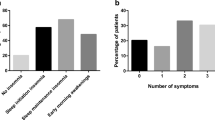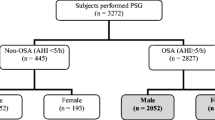Abstract
Background
In clinical practice, we have found that premenopausal women have delayed diagnosis of sleep-disordered breathing (SDB).
Methods
During a 4-year period, we systematically collected the clinical and polysomnographic variables for all women referred for sleep complaints using preestablished questionnaires, scales, clinical grid, polygraphic montage, and scoring criteria. The variables collected on premenopausal SDB women were analyzed and compared to those of postmenopausal women within 5 years of menopause.
Results
Of 977 women, 316 were premenopausal with SDB. Complaints of chronic insomnia and sleepwalking were the most common reasons for referral, had been present for a mean of 6.4 ± 5.4 years, and had lead to unsuccessful symptomatic treatment. The normal-weight premenopausal SDB group had anatomically small upper airways, while those with body mass index (BMI) ≥ 25 kg/m2 complained more frequently of snoring and daytime sleepiness and their clinical presentation was closer to those of the postmenopausal SDB comparison group. Premenopausal women often had a low apnea-hypopnea index (AHI), but there was a discrepancy between the low AHI and the amount of continuous positive airway pressure (CPAP) needed to control the SDB, and there was a need for higher pressures in overweight premenopausal SDB women (mean 9.1 ± 1.9 and 10.1 ± 2.6 cmH2O).
Conclusion
Normal-weight premenopausal SDB women often present with atypical sleep complaints of chronic insomnia and parasomnias. Clinical attention paid to craniofacial features and use of specific scales such as Mallampati help with the suspicion of the presence of SDB, and a low AHI is unrelated to the positive clinical impact of nasal CPAP treatment.


Similar content being viewed by others
Abbreviations
- AHI:
-
Apnea-hypopnea index
- BMI:
-
Body mass index
- BP:
-
Blood pressure
- CPAP:
-
Continuous positive airway pressure
- ESS:
-
Epworth Sleepiness scale
- IQR:
-
Interquartile range
- OSA:
-
Obstructive sleep apnea
- RDI:
-
Respiratory disturbance index
- RERA:
-
Respiratory event-related arousal
- SD:
-
Standard deviation
- SDB:
-
Sleep-disordered breathing
- UARS:
-
Upper-airway resistance syndrome
- 95%:
-
95% confidence interval
References
Young T, Finn L, Austin D, Peterson A (2003) Menopausal status and sleep-disordered breathing in the Wisconsin Sleep Cohort Study. Am J Respir Crit Care Med 167:1181–1185. doi:10.1164/rccm.200209-1055OC
Dancey DR, Hanly PJ, Soong C, Lee B, Hoffstein V (2001) Impact of menopause on the prevalence and severity of sleep apnea. Chest 120:151–155. doi:10.1378/chest.120.1.151
Pickett CK, Regensteiner JG, Woodard WD, Hagerman DD, Weil JV, Moore LG (1989) Progestin and estrogen reduce sleep-disordered breathing in postmenopausal women. J Appl Physiol 66:1656–1661
Popovic RM, White DP (1998) Upper airway muscle activity in normal women: influence of hormonal status. J Appl Physiol 84:1055–1062
Regensteiner JG, Woodard WD, Hagerman DD, Weil JV, Pickett CK, Bender PR, Moore LG (1989) Combined effects of female hormones and metabolic rate on ventilatory drives in women. J Appl Physiol 66:808–813
Bixler EO, Vgontzas AN, Lin HM, Ten Have T, Rein J, Vela-Bueno A, Kales A (2001) Prevalence of sleep-disordered breathing in women: effects of gender. Am J Respir Crit Care Med 163:608–613
Douglass AB, Bornstein R, Nino-Murcia G, Keenan S, Miles L, Zarcone VP Jr, Guilleminault C, Dement WC (1994) The Sleep Disorders Questionnaire I: creation and multivariate structure of SDQ. Sleep 17:160–167
Johns MW (1991) A new method for measuring daytime sleepiness: the Epworth sleepiness scale. Sleep 14:540–545
Friedman M, Tanyeri H, La Rosa M, Landsberg R, Vaidyanathan K, Pieri S, Caldarelli D (1999) Clinical predictors of obstructive sleep apnea. Laryngoscope 109:1901–1907. doi:10.1097/00005537-199912000-00002
Mallampati SR, Gatt SP, Gugino LD, Desai SP, Waraksa B, Freiberger D, Liu PL (1985) A clinical sign to predict difficult tracheal intubation: a prospective study. Can Anaesth Soc J 32:429–434
Soules MR, Sherman S, Parrott E, Rebar R, Santoro N, Utian W, Woods N (2001) Executive summary: Stages of Reproductive Aging Workshop (STRAW). Fertil Steril 76:874–878. doi:10.1016/S0015-0282(01)02909-0
Kushida CA, Giacomini A, Lee MK, Guilleminault C, Dement WC (2002) Technical protocol for the use of esophageal manometry in the diagnosis of sleep-related breathing disorders. Sleep Med 3:163–173. doi:10.1016/S1389-9457(01)00143-5
Rechtschaffen A, Kales A (1968) A manual of standardized terminology, techniques and scoring system for sleep stages of human subjects. Brain Information Service, Los Angeles
American Sleep Disorders Association (1992) EEG arousals: scoring rules and examples: a preliminary report from the Sleep Disorders Atlas Task Force of the American Sleep Disorders Association. Sleep 15:173–184
American Academy of Sleep Medicine (1999) Sleep-related breathing disorders in adults: recommendations for syndrome definition and measurement techniques in clinical research. The Report of the American Academy of Sleep Medicine Task Force. Sleep 22:667–689
Ayappa I, Norman RG, Krieger AC, Rosen A, O’Malley RL, Rapoport DM (2000) Non-invasive detection of respiratory effort-related arousals (RERAs) by a nasal cannula/pressure transducer system. Sleep 23:763–771
Guilleminault C, Poyares D, Palombini L, Koester U, Pelin Z, Black J (2001) Variability of respiratory effort in relationship with sleep stages in normal controls and Upper Airway Resistance Syndrome patients. Sleep Med 2:397–406. doi:10.1016/S1389-9457(01)00111-3
Bao GC (2004) Upper airway resistance syndrome—one decade later. Curr Opin Pulm Med 10:461–467. doi:10.1097/01.mcp.0000143689.86819.c2
Chobanian AV, Bakris GL, Black HR, Cushman WC, Green LA, Izzo JL Jr, Jones DW, Materson BJ, Oparil S, Wright JT Jr, Roccella EJ, National Heart, Lung, Blood Institute Joint National Committee on Prevention, Detection, Evaluation, Treatment of High Blood Pressure; National High Blood Pressure Education Program Coordinating Committee (2003) The Seventh Report of the Joint National Committee on Prevention, Detection, Evaluation, and Treatment of High Blood Pressure: the JNC 7 report. JAMA 289:2560–2572. doi:10.1001/jama.289.19.2560
National Heart Lung Blood Institute in cooperation with The National Institute of Diabetes, Digestive, Kidney Disease (1998) Clinical guidelines on the identification, evaluation, and treatment of overweight and obesity in adults. The evidence report. NIH Publication No. 98–4083. National Institutes of Health, Bethesda, MD
Friberg D, Ansved T, Borg K, Carlsson-Nordlander B, Larsson H, Svanborg E (1998) Histological indications of a progressive snorers’ disease in an upper-airway muscle. Am J Respir Crit Care Med 157:586–593
Friberg D (1999) Heavy snorer’s disease: a progressive local neuropathy. Acta Otolaryngol 119:925–933. doi:10.1080/00016489950180306
Guilleminault C, Huang YS, Kirisoglu C, Chan A (2005) Is obstructive sleep apnea a neurological disorder? Ann Neurol 58:880–887. doi:10.1002/ana.20654
Léger D, Guilleminault C, Dreyfus JP, Delahaye C, Paillard M (2000) Prevalence of insomnia in a survey of 12778 adults in France. J Sleep Res 9:35–42. doi:10.1046/j.1365-2869.2000.00178.x
Guilleminault C, Palombini L, Poyares D, Takaoka S, Huynh NT, El-Sayed Y (2007) Pre-eclampsia and nasal CPAP: Part 1. Early intervention with nasal CPAP in pregnant women with risk-factors for pre-eclampsia: preliminary findings. Sleep Med 9:9–14. doi:10.1016/j.sleep.2007.04.020
Poyares D, Guilleminault C, Hachul H, Fujita L, Takaoka S, Tufik S, Sass N (2007) Pre-eclampsia and nasal CPAP: Part 2. Hypertension during pregnancy, chronic snoring, and early nasal CPAP intervention. Sleep Med 9:15–21. doi:10.1016/j.sleep.2007.04.019
Acknowledgments
Visasiri Tantrakul was supported by a fellowship scholarship from Ramathibodi Hospital, Mahidol University, Bangkok, Thailand. We thank Christine Won for assisting with data collection.
Author information
Authors and Affiliations
Corresponding author
Rights and permissions
About this article
Cite this article
Tantrakul, V., Guilleminault, C. Chronic Sleep Complaints in Premenopausal Women and Their Association with Sleep-Disordered Breathing. Lung 187, 82–92 (2009). https://doi.org/10.1007/s00408-009-9137-7
Received:
Accepted:
Published:
Issue Date:
DOI: https://doi.org/10.1007/s00408-009-9137-7




